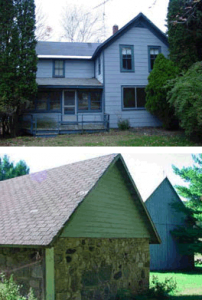Werner Farm
 History
History
This 204-acre parcel of land was claimed by Frederick and Maragetta Werner, who arrived from Germany on 1855. The Werners, who were related to Carsten and Elizabeth Burfiend, were the second family to move to the Pyramid Point area. Their farm dates to the late 1850s or early 1860s, making it the oldest mainland unit surviving from the early settlement period. In 1885, the Werner’s son and daughter-in-law, Richard and Katie Werner, were farming at this site. After Richard’s death in 1890, Katie married Benjamin Holland, who took over the farm. By 1891, Frederick and Margaretta Werner had divided their parcel, ceding the northern 122 acres to their daughter and son-in-law, Maggie and John Miller.
Fredrick and Margaretta Werner’s great-grandson, Franklin Basch, was raised on the farm and purchased it in 1943. His father, Claus Basch, ran a mail boat between North Manitou Island, and Leland and lived for a time in New York City. According to Franklin Basch, their farming activities ceased around 1930 because they were unable to produce adequate crops. As with most area farmers, they raised potatoes, corn, and grains. It was the third most valuable farm in Port Oneida.
The Werners owned four milk cows. The cows, which produced cream for 500 pounds of butter, led all other Port Oneida dairy operations. They also made a profit from their forest products and from the sale or slaughter of animals. The total profit for 1870 was the third highest in the area, following Thomas Kelderhouse and Carsten Burfiend, respectively. They maintained a small orchard of apple and peach trees. Existing structures include a barn, stone barn, garage, granary/corn crib and privy. The barn is one of the largest in the area, and the stone building is one of only two masonry structures in Port Oneida. For being the oldest farm, it is remarkable to be in such good condition. *Resource: Farming at the Water’s Edge


 Official Partner of the
Official Partner of the